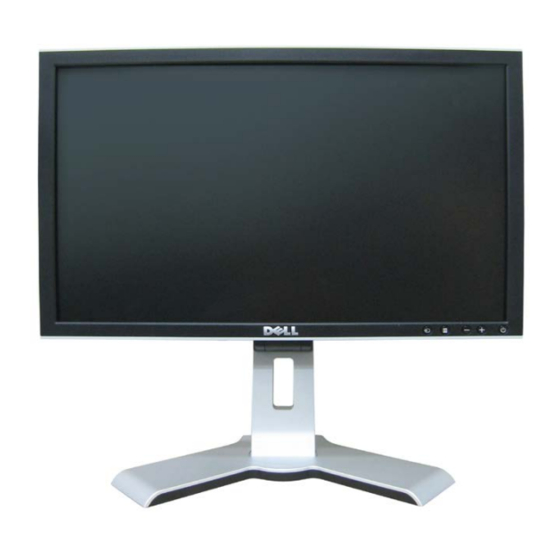Dell 1908WFP - UltraSharp - 19" LCD Monitor Benutzerhandbuch - Seite 34
Blättern Sie online oder laden Sie pdf Benutzerhandbuch für Monitor Dell 1908WFP - UltraSharp - 19" LCD Monitor herunter. Dell 1908WFP - UltraSharp - 19" LCD Monitor 40 Seiten. Flat panel monitor
Auch für Dell 1908WFP - UltraSharp - 19" LCD Monitor: Setup-Handbuch (2 seiten), Spezifikationen (2 seiten)

Solving Problems: Dell 1908WFP Flat Panel Monitor User's Guide
Universal Serial Bus (USB) Specific Probelms
SPECIFIC SYMPTOMS
USB interface is not working
High Speed USB 2.0 interface is slow High Speed USB 2.0 peripherals working slowly or not at all.
Troubleshooting the Dell™ Soundbar
COMMON
WHAT YOU EXPERIENCE
SYMPTOMS
No Sound
No power to Soundbar - the power
indicator is off.
(built-in DC power supply. i.e. 1905FP
)
No Sound
Soundbar has power - power indicator
is on.
Distorted Sound
Computer's sound card is used as the
audio source.
Distorted Sound
Other audio source is used.
Unbalanced Sound
Sound from only one side of
Output
Soundbar
file:///T|/htdocs/monitors/1908WFP/en/ug/solve.htm[10/31/2012 11:34:36 AM]
WHAT YOU EXPERIENCE
USB peripherals are not working.
Turn the Power/Volume knob on the Soundbar clockwise to the middle position; check if the power indicator (green LED)
on the front of the Soundbar is illuminated.
Confirm that the power cable from the Soundbar is plugged into the monitor.
Confirm that the monitor has power.
If the monitor has no power, see
Plug the audio line-in cable into the computer's audio out jack.
Set all Windows volume controls to their maximum.
Play some audio content on the computer (i.e. audio CD, or MP3).
Turn the Power/Volume knob on the Soundbar clockwise to a higher volume setting.
Clean and reseat the audio line-in plug.
Test the Soundbar using another audio source (i.e. portable CD player).
Clear any obstructions between the Soundbar and the user.
Confirm that the audio line-in plug is completely inserted into the jack of the sound card.
Set all Windows volume controls to their midpoints.
Decrease the volume of the audio application.
Turn the Power/Volume knob on the Soundbar counter-clockwise to a lower volume setting.
Clean and reseat the audio line-in plug.
Troubleshoot the computer's sound card.
Test the Soundbar using another audio source (i.e. portable CD player).
Clear any obstructions between the Soundbar and the user.
Confirm that the audio line-in plug is completely inserted into the jack of the audio source.
Decrease the volume of the audio source.
Turn the Power/Volume knob on the Soundbar counter-clockwise to a lower volume setting.
Clean and reseat the audio line-in plug.
Clear any obstructions between the Soundbar and the user.
Confirm that the audio line-in plug is completely inserted into the jack of the sound card or audio source.
Set all Windows audio balance controls (L-R) to their midpoints.
Clean and reseat the audio line-in plug.
Troubleshoot the computer's sound card.
Test the Soundbar using another audio source (i.e. portable CD player).
POSSIBLE SOLUTIONS
Check that your monitor is turned ON.
Reconnect the upstream cable to your computer.
Reconnect the USB peripherals (downstream connector).
Switch off and then turn on the monitor again.
Check that your computer is USB 2.0 capable.
Verify USB 2.0 source on your computer.
Reconnect the upstream cable to your computer.
Reconnect the USB peripherals (downstream connector).
POSSIBLE SOLUTIONS
Troubleshooting your monitor
for monitor common problem.
